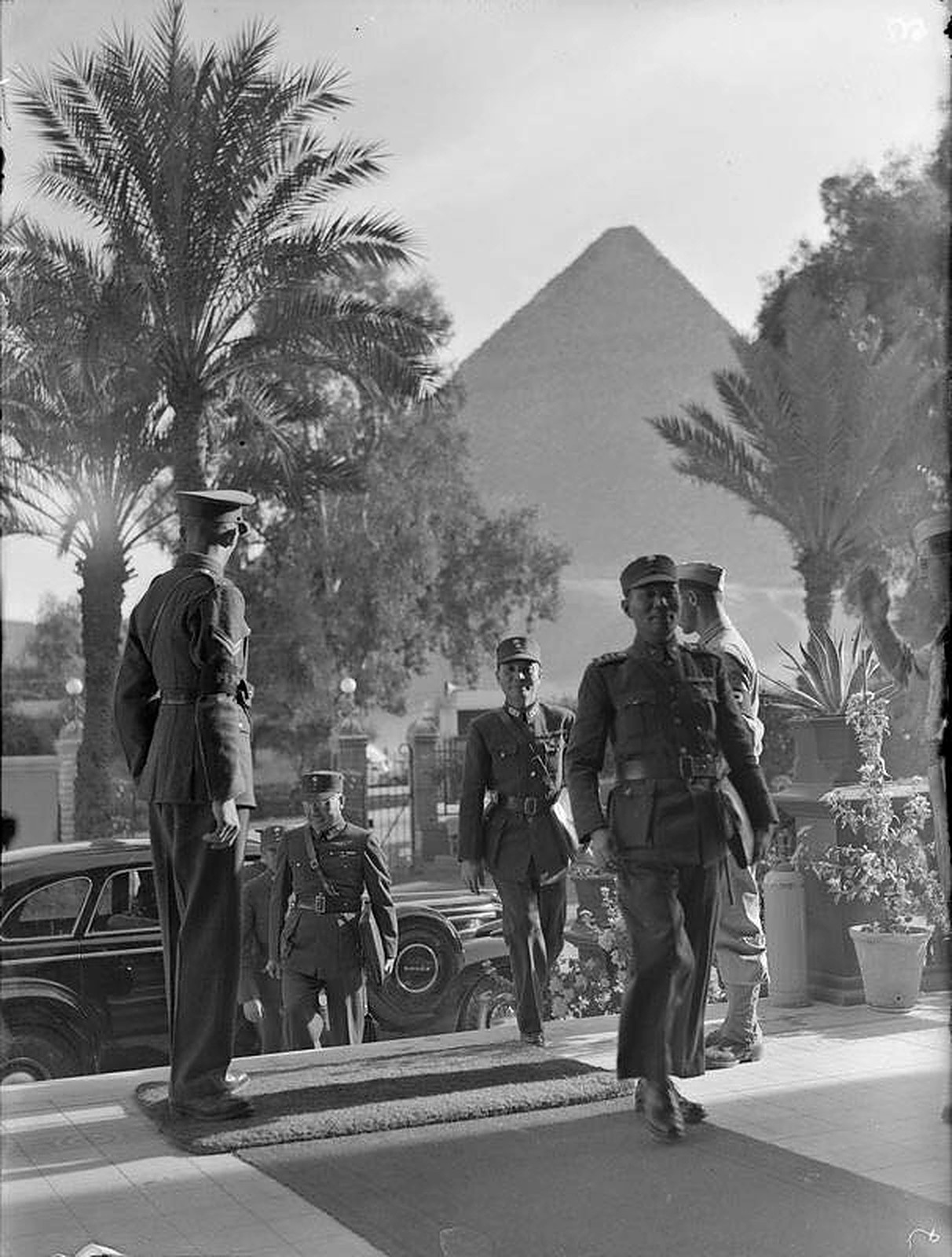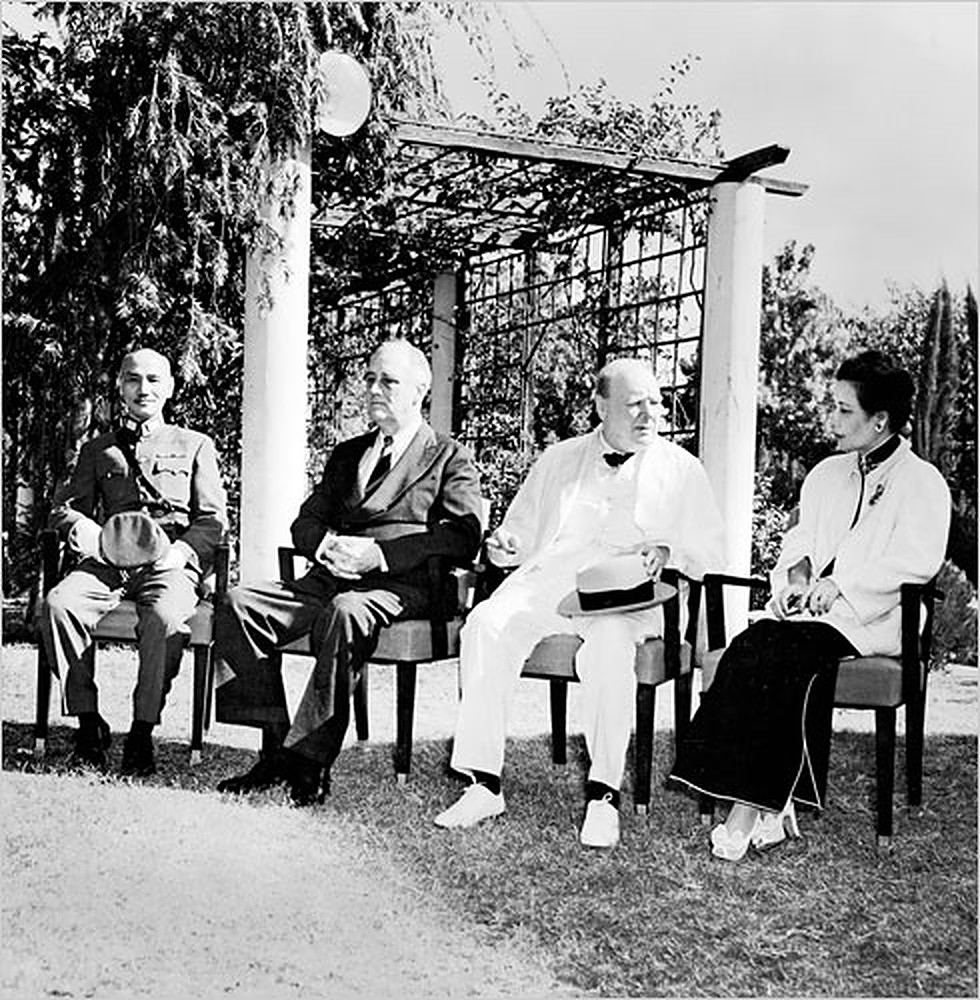Near the Giza pyramids at the American Ambassador to Egypt’s residency, world leaders from the US, Britain and China met for the first time in 1943 in November and December to discuss peace and plans for the postwar world order. It was a rare occurrence that witnessed the joining of forces between the West and China, and also the draft of Cairo Declaration that changed the history and the world’s political landscape.
The Cairo Conference represented the main idealistic vision by US President Franklin D. Roosevelt, who hoped to create a new global order that would maintain peace and create the hegemonic structure of the United Nations, which is now led by the five permanent powers of the Security Council: China, France, Russia (formerly the Soviet Union), the United Kingdom, and the United States. However, some historians question the successes of this vision, and whether it promoted more unity or hostility in current international relations.
BACKGROUND
Earlier in 1943, former President of the US Roosevelt and former President of China Chiang Chungcheng (also known as Generalissimo Chiang) expressed a mutual desire for a personal meeting in the autumn to ascertain America’s political objectives in Asia and military strategy in the war. Previously, Chiang was furious that Roosevelt and Churchill met at Casablanca in January 1943 without inviting him, and warned Roosevelt that rejection would force him to negotiate an accommodation with Japan and leave the war.
According to biographer James MacGregor Burns, Roosevelt therefore became committed to his two aims for China: to use it as a central base for the final attack on Japan, and to treat it as a great power that could be a bulwark of stability in Asia after the war and American co-operation with Asia.
He envisioned the creation of a cooperative world order in which a dominant power in each major region would be responsible for ensuring stability in the region, and ensure the success behind the philosophy of the United Nations and the achievement of world peace, as noted by historian James I. Matray.
Roosevelt wrote to former Prime Minister of Britain, Winston Churchill, asking whether “he would like to meet in North Africa or even at the Pyramids, and towards the close of our talks get Generalissimo Chiang to join us for two or three days?” The Prime Minister later replied he would be delighted to meet the President.
This would be the first and last time that these leaders would meet.
THE MEETING AT THE PYRAMIDS

According to A. Whitfield in Hong Kong, Empire and the Anglo-American Alliance, none of the leaders were entirely certain as to the aims of the Cairo conference, and in actuality, the conference heightened the tensions and their misconceptions about each other despite the drafting of the Cairo Declaration.
To Churchill’s dismay, the conference was centered more on America and China’s relations, as the Americans were more interested in winning the support of the Chinese in the war and treating them as a global power. The conference was described as ‘lengthy and complicated’ by Churchill, who was not wholly convinced of the idea of China deserving treatment as a great power. As historian Bruce Cumings observes, Churchill “thought it naïve and illusory, even whimsical,” to expect China to play a positive role in postwar East Asia.
It was not entirely optimistic for the Americans either, as according to James I. Matray, Roosevelt the next day began suspecting China’s role as a partner and conveyed fears regarding China’s aspirations for dominance in Asia to Churchill. Therefore, the Cairo Declaration developed to become more of a block against China’s ambitions, which included a specific renunciation by the Chinese of any goals to expand in Asia and compel Generalissimo Chiang to support national self-determination for those nations liberated from Japanese domination.
The leaders also agreed “on future military operations against Japan and to bring unrelenting pressure against their brutal enemies by sea, land and air,” as stated in a general stated issued after conference, and that “Japan shall be stripped of all the islands in the Pacific which she has seized or occupied since the beginning of the first World War in 1914” and “that in due course Korea shall become free and independent.”
The most satisfied party was China, as Generalissimo Chiang was pleased that the country would finally be recognized and treated as a global power by the West.
Historian Arnold Xiangze Jiang describes the conference as “the most striking demonstration of the international acceptance of China as a great power” in modern history.

AFTERMATHS

Ronald Heiferman notes that the Cairo Conference provided the backdrop for the Yalta Conference, as Roosevelt was keen in fulfilling the Cairo Declaration. Roosevelt gained Stalin’s commitment of support for Chiang’s government and discussed Korea, resulting in an informal agreement for imposing a multinational trusteeship to prevent the Sovietization of post war Korea.
The Potsdam Declaration, which marked the near end of the Second World War in 1945 and the conclusion of peace treaties, also reaffirmed the terms of the Cairo Declaration, as it stated that “Japanese sovereignty shall be limited to the islands of Honshu, Hokkaido, Kyushu, Shikoku and such minor islands as we determine” and its military forces “be completely disarmed.”
However, historians debate as to whether Roosevelt’s vision of a cooperative and peaceful world order ensued following the war. James I. Matray, for instance, argues that the emergence of the Cold War between the US and the Soviet Union was responsible for preventing the United States from achieving the main goals it had identified in the Cairo Declaration.
Soviet expansion in Eastern Europe and activities in Korea begun to alarm US leaders, as the new president, Harry Truman, feared that Korea would be similar to Poland that was under Soviet influence. When Stalin sent the Red Army into Korea prematurely on August 12, the United States responded by dividing Korea into Soviet and American zones of military occupation at the 38th parallel.
Things began to escalate further during the Pacific war and the proclamation of China as a Communist country. Though Truman tried to commit to the Cairo Declaration by rushing 40,000 US Marines to Beijing, it resulted in huge losses and the Communist victory in the war.
William Samuel Hitchcock notes that the Cairo Conference demonstrates how America’s policy in Asia followed a course of opportunistic action to defeat the enemy during the Second World War rather than a concrete program that would build the foundation for the future.
Nevertheless, Gao Hong highlights that the Cairo Declaration proved the illegitimacy of Japan’s occupation of Chinese territory, and that Japan’s denial of the Cairo Declaration would be against its peaceful development path after World War II.
“The Cairo Declaration’s spirit and principles still need to be upheld today to protect world peace,” he states, “the guidelines and principles created to deal with Japan following World War II should continue to stand as lawful documents to which the international community abides.”






Comments (0)